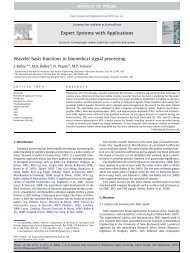Wavelet basis functions in biomedical signal processing - SPAN LAB
Wavelet basis functions in biomedical signal processing - SPAN LAB
Wavelet basis functions in biomedical signal processing - SPAN LAB
You also want an ePaper? Increase the reach of your titles
YUMPU automatically turns print PDFs into web optimized ePapers that Google loves.
J. Rafiee et al. / Expert Systems with Applications 38 (2011) 6190–6201 619320 Normal (Neutral)151000.025 (Neutral)1055005050.08 (Neutral)60Normal (Erotic)20040100200805050.025 (Erotic)0.08 (Erotic)604040202005(Hz)05(Hz)Fig. 5. Power spectrum density (V 2 /Hz) of VPA recorded <strong>in</strong> six classes (one specific subject).The CWT results <strong>in</strong> cont<strong>in</strong>uous wavelet coefficients (CWC),which illustrate how well a wavelet function correlates with a specific<strong>signal</strong>. If the <strong>signal</strong> has a major frequency component correspond<strong>in</strong>gto a particular scale, then the wavelet at this scale issimilar to the <strong>signal</strong> at the location where this frequency componentoccurs, regardless of its amplitudes and phases. Correlationis one of the most common statistical measures, and describesthe degree of l<strong>in</strong>ear dependence between two variables <strong>in</strong> termsof a coefficient between 1 and +1. The closer the coefficient isto either 1 or +1, the stronger the correlation between the twovariables. The negative or positive sign of the coefficient <strong>in</strong>dicatesthe direction of the l<strong>in</strong>ear dependence. The coefficient 0 impliesthat the two variables are completely l<strong>in</strong>early <strong>in</strong>dependent of eachother. q x,y , the correlation between two random variables x and ywith expected values l x and l y and standard deviations r x andr y is def<strong>in</strong>ed as:covðx; yÞq x;y¼ ¼ Eððx l x Þðy l y ÞÞ; ð3Þr x r y r x r ywhere E stands for expected value of the variable and cov stands forcovariance. As E(x)=l x , E(y)=l y and r 2 (x)=E(x 2 ) E 2 (x),r 2 (y)=E(y 2 ) E 2 (y), q x,y can be def<strong>in</strong>ed as:EðxyÞ EðxÞEðyÞq x;y¼ qffiffiffiffiffiffiffiffiffiffiffiffiffiffiffiffiffiffiffiffiffiffiffiffiffiffiffiqffiffiffiffiffiffiffiffiffiffiffiffiffiffiffiffiffiffiffiffiffiffiffiffiffiffiffiffiEðx 2 Þ E 2 ðxÞ Eðy 2 Þ E 2 ðyÞIn this research, the outcome of the correlation between <strong>signal</strong>and wavelet <strong>basis</strong> function (CWC) has been established as the <strong>basis</strong>for compar<strong>in</strong>g selected mother wavelet <strong>functions</strong>. Consequently,ð4Þto f<strong>in</strong>d the most similar mother wavelet to bio<strong>signal</strong>s, motherwavelets from different families <strong>in</strong>clud<strong>in</strong>g Haar, Daubechies (db),Symlet, Coiflet, Gaussian, Morlet, complex Morlet, Mexican hat,bio-orthogonal, reverse bio-orthogonal, Meyer, discrete approximationof Meyer, complex Gaussian, Shannon, and frequency B-spl<strong>in</strong>efamilies have been analyzed based on CWC and us<strong>in</strong>g the follow<strong>in</strong>galgorithm:1. Signal segmentation: EMG, EEG, VPA <strong>signal</strong>s were segmented tothe 256-po<strong>in</strong>ts, 500-po<strong>in</strong>ts, 960-po<strong>in</strong>ts (12 s) w<strong>in</strong>dows, respectivelyas shown <strong>in</strong> Figs. 6 and 7 for EMG and VPA.2. One class of recorded data is selected from one channel for onesubject for each type of bio<strong>signal</strong>. The number of subjects is 20,6, and 1 for VPA, EMG, and EEG, respectively. There are 1, 16, 6,and 3 channels for record<strong>in</strong>g the <strong>signal</strong>s for VPA, surface EMG,<strong>in</strong>tramuscular EMG, and EEG, respectively.3. One mother wavelet function is selected from 324 candidates.In the fourth decomposition level, CWC of the segmented <strong>signal</strong>swere calculated (2 4 numbers for each segmented <strong>signal</strong>).4. Absolute value of CWC <strong>in</strong> each scale (2 4 scales) was determ<strong>in</strong>edus<strong>in</strong>g 324 mother wavelets <strong>in</strong> a segmented <strong>signal</strong> for each of the10 hand motions for EMG, as well as each of three specific channelsfor EEG. Next, the sum of this value <strong>in</strong> all 2 4 scales wasdeterm<strong>in</strong>ed for 20 EMG segmented <strong>signal</strong>s (<strong>signal</strong>s with thelength of 256 po<strong>in</strong>ts), 50 EEG segmented <strong>signal</strong>s (<strong>signal</strong>s withthe length of 500 po<strong>in</strong>ts), and 15 VPA segmented <strong>signal</strong>s (<strong>signal</strong>swith the length of 960 po<strong>in</strong>ts). Their average was calculatedfor each type of <strong>signal</strong> and called the evaluationcriterion (EC) for simplicity and to f<strong>in</strong>d the most similar mother





